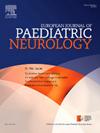Development in children with neurofibromatosis type 1 in early childhood
IF 2.3
3区 医学
Q3 CLINICAL NEUROLOGY
引用次数: 0
Abstract
Introduction
The development of children with NF1 has so far been primarily studied in school-age children with various subtests showing heterogeneous profiles. The aim of this study is to characterise the development of infants with NF1 across all areas of early childhood development.
Material and methods
32 infants with NF1, aged 12–47 months, participated in this cross-sectional cohort study. Development was assessed with the MFED 1–4 comprising 7 test categories. Items measuring visual abilities (colour and visuospatial items) from all subcategories were selected and compared to the normal population.
Results
Infants with NF1 showed a global developmental delay, more pronounced in application of memorised knowledge. A particular deficit was found in items requiring spatial vision.
Discussion
The present study is the first to examine the global development of children with NF1 under 48 months. Consistent with animal data, we found significant deficits in visuospatial abilities, which may significantly contribute to the perceived global developmental delay. These findings underline the need for early and specific developmental therapy in this patient group in order to train the development early in infancy and to achieve the best neurodevelopmental outcome.
儿童早期1型神经纤维瘤病的发展
迄今为止,NF1儿童的发展主要是在学龄儿童中进行的,各种子测试显示出不同的特征。本研究的目的是在儿童早期发育的所有领域描述NF1婴儿的发育特征。材料与方法32例NF1患儿,年龄12-47个月,参与本横断面队列研究。发展评估与MFED 1-4,包括7个测试类别。从所有子类别中选择测量视觉能力的项目(颜色和视觉空间项目)并与正常人群进行比较。结果NF1患儿表现出全面的发育迟缓,在记忆知识的应用方面更为明显。在需要空间视觉的项目中发现了一种特殊的缺陷。本研究首次调查了48个月以下NF1儿童的全球发展情况。与动物数据一致,我们发现了视觉空间能力的显著缺陷,这可能是感知到的整体发育迟缓的重要原因。这些发现强调需要在该患者群体中进行早期和特定的发育治疗,以便在婴儿期早期训练发育并实现最佳的神经发育结果。
本文章由计算机程序翻译,如有差异,请以英文原文为准。
求助全文
约1分钟内获得全文
求助全文
来源期刊
CiteScore
6.30
自引率
3.20%
发文量
115
审稿时长
81 days
期刊介绍:
The European Journal of Paediatric Neurology is the Official Journal of the European Paediatric Neurology Society, successor to the long-established European Federation of Child Neurology Societies.
Under the guidance of a prestigious International editorial board, this multi-disciplinary journal publishes exciting clinical and experimental research in this rapidly expanding field. High quality papers written by leading experts encompass all the major diseases including epilepsy, movement disorders, neuromuscular disorders, neurodegenerative disorders and intellectual disability.
Other exciting highlights include articles on brain imaging and neonatal neurology, and the publication of regularly updated tables relating to the main groups of disorders.

 求助内容:
求助内容: 应助结果提醒方式:
应助结果提醒方式:


